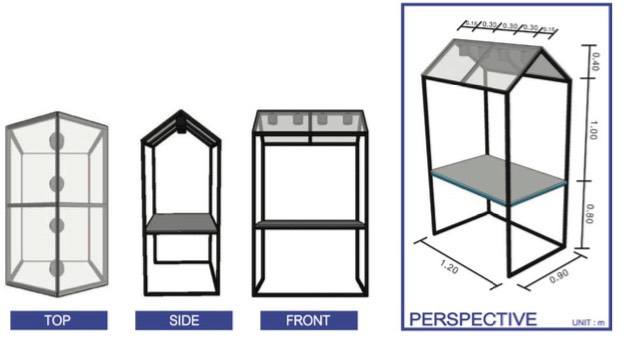A Hands-on Recommendation of Artificial Lighting for Promoting Product Appeal in Fresh Markets
DOI:
https://doi.org/10.56261/built.v19.246433Keywords:
lighting design, lighting, sales promotion, fresh marketAbstract
This descriptive study aims to help sellers in fresh markets be aware of the importance of artificial lighting in promoting the appeal of their products and apply it at their stalls. This study was conducted in three stages, with two objectives, to 1) gain insights regarding types of artificial lights used at the stalls and common product types sold at the selected fresh markets, and 2) identify the artificial lighting that suits each type of the common products. Insights from four popular markets in Bangkok were gained during the Exploration Stage. Most sellers were using fluorescents in cool white, warm white, and mixed white, and incandescents provided by the market management. Vegetables, fruits, seafood, meats, and desserts were the common food products sold. The dimensions of the stalls at the markets were in a similar range. Such information was used to design mockup stalls at the Design Stage; they were installed with each type of artificial lighting. The mockups were used during the Testing Stage when the lighting was shining on the food products. The respondents rated that mix-white fluorescents helped vegetables, fruits, and seafood look appealing, and so did the warm white fluorescents for meats and desserts. The results of this study led to a recommendation addressing the Correlated Color Temperature effects on the appeal of products and how sellers can select off-the-shelf light bulbs suiting their products.
Downloads
References
Ames, J. (2020, March 29). What is CCT? A guide to choosing correlated color temperature for your lighting. https://insights.regencylighting.com/what-is-correlated-color-temperature-cct-and-how-do-you-choose-it-for-your-lighting
Birren, F. (1969). Light, color and environment. New York: Van Nostrand Reinhold.
Chiwakul, K. Watanapasuk, J., Thadaniti, S., Atibodhi, K., Nakeeraket, C., & Nakavachara, N. Markets in Bangkok: expansion and development. Chulalongkorn University.
Department for Environment Food and Rural Affairs. (2006). Statutory Nuisance from Insects and Artificial Light. Department for Environment Food and Rural Affairs.
European Commission. (2020, March 29). Health effects of artificial light. https://ec.europa.eu/health/scientific_committees/opinions_layman/artificial-light/en/l-3/2-technologies.htm
Ganslandt, R., & Hofmann, H. (1992). Handbook of lighting design. Lüdenscheid: Druckhaus Maack.
Gmbh, A. (2013). Architectural lighting. Mülheim an der Ruhr: Ansorg GmbH
Illuminating Engineering Society. (2011). The lighting handbook. (10th ed.). Illuminating Engineering Society.
Kaufman, J. E. (1966). IES lighting handbook: Reference & application. New York: Illuminating Engineering Society.
Kaufman, R. C. (1974). A biographical note on Faber Birren. The Faber Birren collection on color in the art library, 49(1), 73-75. https://www.jstor.org/stable/40858539
Kay, G. N. (1999). Fiber optics in architectural lighting: methods, design, and applications. Boston: McGraw-Hill.
Knez, I. (2001). Effects of colour of light on nonvisual psychological process. Journal of Environmental Psychology, 21(2), 201-208. https://doi.org/10.1006/jevp.2000.0198
Lumens. (2022, March 24). Understanding color rendering index. https://www.lumens.com/how-tos-and-advice/color-rendering-index.html
Luxsystems. (2020, March 31). Tips to get your restaurant’s lighting right. https://www.luxsystems.com/en/blog/ligthing/post/tips-get-your-restaurants-lighting-right
Michel, L. (1995). Light: The shape of space: Designing with space and light. New York: John Wiley & Sons.
Philips. (2020, March 31). ร้านค้าแห่งความเป็นไปได้. https://www.lighting.philips.co.th/systems/system-areas/food-large-retailers
Pritchard, D. C. (1995). Lighting. (5th ed.). London: Longman Scientific & Technical.
Rea, M., Figueiro, M., Bullough, J. (2002). Circadian photobiology: an emerging framework for lighting practice and research. Lighting Research & Technology, 34(3), 177-187.
Silva, E. M. (2017). Bridging fashion design and color effects. In M. M. Soares & F. Rebelo (Eds.), Ergonomics in design: methods and techniques (pp. 55–72). CRC Press.
Turner, J. (1994). Lighting: an introduction to light, lighting and light use. London: B.T. Batsford.
Turner, J. (1998). Designing with light: retail spaces lighting solutions for shops, malls and markets. New York: Watson-Guptill.
Webstaurant Store. (2020, March 31). Types of restaurant lighting. https://www.webstaurantstore.com/article/7/restaurant-lighting.html
Whitehead, R. (1998). The Art of Lighting: An International Profile of House Lighting. Rockport Publishers.
Whitehead, R. (2009). Residential Lighting: A Practical Guide to Beautiful and Sustainable Design (2nd ed.). John Wiley & Sons.
Youyuenyong, P. (2013). Architectural lighting, light pollution & law. Art and architecture Journal Naresuan University. pp. 19-21.

Downloads
Published
How to Cite
Issue
Section
License
Copyright (c) 2022 International Journal of Building, Urban, Interior and Landscape Technology (BUILT)

This work is licensed under a Creative Commons Attribution-NonCommercial-NoDerivatives 4.0 International License.











